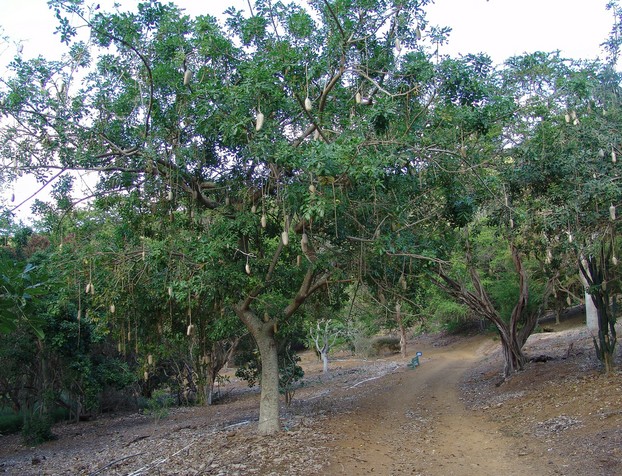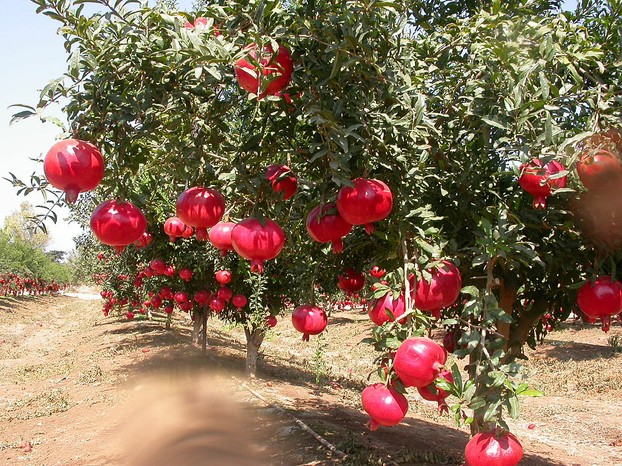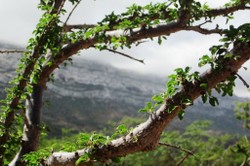Persephone, Queen of the Underworld, would have suffered an easier fate if she had accessed the less palatable Socotran Pomegranate.
Persephone's fate was determined by the number of pomegranate seeds that she consumed.
"Persephone"; 1874 oil on canvas by Dante Gabriel Rossetti (May 12, 1828-April 9, 1882): Public Domain, via Wikimedia Commons @ https://commons.wikimedia.org/wiki/File:Dante_Gabriel_Rossetti_-_Proserpine_-_Google_Art_Project.jpg
Brambling, rambling sprawl of Socotran Pomegranate Tree, with branches cascading toward the ground, often peeks inconspicuously around more distinctive, unusual trees in its landscape.
P. protopunica (far left) is overshadowed by continental African native sausage tree (Kigelia), Koko Crater Botanical Garden: Drew Avery, CC BY 2.0, via Flickr @ https://www.flickr.com/photos/33590535@N06/3616599739/
Star of Punica genus, with worldwide admirers, Punica granatum overshadows its sibling species, Punica protopunica.
Punica granatum orchard; Tuesday, September 25, 2007, 11:01: Bhanji11, CC BY SA 3.0, via Wikimedia Commons @ https://commons.wikimedia.org/wiki/File:Anar(Pomegranate).jpg
Lythrum salicaria: in same botanical family as Socotra Pomegranate Tree
Middle Rhine, central Germany: Manfred Heyde, CC BY-SA 3.0, via Wikimedia Commons @ https://commons.wikimedia.org/wiki/File:Lythrum_salicaria_Rhine.jpg
The small Punica genus, with only two species, honors the ancient world's great seafarers, the Phoenicians.
Phoenician horses'-heads ships (hippoi) transporting cedar: relief from palace of Sargon II (King of Babylonia 722-705 BC) at Dur Sharrukin, Assyria (now Khorsabad, Iraq), ca. 713-716 BC
Louvre Museum; excavated 1843-1844 by Paul-Émile Botta (December 6, 1802-March 29, 1870): Marie-Lan Nguyen (Jastrow), Public Domain, via Wikimedia Commons @ https://commons.wikimedia.org/wiki/File:Transport_cedar_Dur_Sharrukin_Louvre_AO19890.jpg
Locations, names and routes of "Periplus of the Erythraean Sea", Greco-Roman sailing navigation and trading list, 1st century CE
In Greco-Roman world, Socotra was known as Dioscoridus Island: PHGCOM, CC BY-SA 4.0, via Wikimedia Commons (caption in Pomegranate red [rgb 238, 50, 51] added by Derdriu) @ https://commons.wikimedia.org/wiki/File:Map_of_the_Periplus_of_the_Erythraean_Sea.jpg
four islands of Socotran Archipelago
topographic map of Socotra Archipelago: Oona Räisänen (Mysid), CC BY-SA 4.0, via Wikimedia Commons @ https://en.wikipedia.org/wiki/File:Topographic_map_of_Socotra-en.svg
Isaac Bayley Balfour: describer and namer of Socotra Pomegranate Tree
1882 portrait by Maull & Fox (Henry Maul [1832-1907], John Fox [1832-1907]): Bibliothèque nationale de France, Public Domain, via Wikimedia Commons @ https://en.wikipedia.org/wiki/File:Isaac_Bayley_Balfour,_Maull_&_Fox,_BNF_Gallica.jpg
Punica protopunica lithograph by Walter Hood Fitch (Feb 28, 1817-Jan 14, 1892); Nicholas Hanhart (1815-1902), imp. (printer); Figure 1 natural size, rest magnified
1-branch with flowers; 2-flower-bud: vertical section; 3-expanded flower: vertical section; 4-gynaeceum on bibracteolate flower stalk; 5-2 stamens; 6-ovary transverse section; 7-fruit; 8-fruit vertical section
Isaac Bayley Balfour, Botany of Socotra (1888), Tab. XXV: Public Domain, via Biodiversity Heritage Library @ https://www.biodiversitylibrary.org/page/41401576
Red shading marks Socotra's granite core, where Haghier Mountains (1 of Socotran pomegranate's habitats) are located.
Henry O. Forbes, Natural History (1903), page xvii: Biodiversity Heritage Library (BioDivLibrary), CC BY 2.0, via Flickr @ https://www.flickr.com/photos/biodivlibrary/26688649406/
One of the earth's most isolated islands, Socotra is of continental --- not volcanic --- origin.
Gouged with deep valleys (wadis), Diksam Plateau also is interlaced with karstic caves in which Belgian speleologists in 2001 discovered drawings and text, from 1st century BC to 6th century AD, in variety of scripts (Brahmi, Ethiopian, Greek, etc.).
Dixsam, limestone plateau in the middle of Socotra where Socotra pomegranate trees grow; Monday, December 7, 2009, 10:46: Email4mobile, Public Domain, via Wikimedia Commons @ https://en.wikipedia.org/wiki/File:Socotra_-Dixam00.JPG
Diksam Plateau: a seemingly hardscrabble environment in which Socotra's unique flora, including Punica protopunica, have flourished since time immemorial
road to Oasis of Wadi Daerhu, Diksam Plateau, central Socotra; Wednesday, June 16, 2010, 14:24:43: Gerry and Bonni, CC BY 2.0, via Flickr @ https://www.flickr.com/photos/gerr-bon/6407175757/
view from Tamarida Bay, north coast, Socotra
1898 photograph of Hadibu and Haghier Mountains, Socotra Pomegranate Tree's habitat
Henry O. Forbes, Natural History of Sokotra (1903), page xxxii, Public Domain, via Wikimedia Commons @ https://commons.wikimedia.org/wiki/File:View_of_Hadibu_and_the_Haghier_Mountains_from_Tamarida_Bay.jpg
Puzzlement of true birthplace of pomegranates (Punica): Aphrodite, goddess of beauty and love, is credited with gifting her birthplace, Cyprus, with pomegranates. This legend suggests the tree's nonindigenous origin. So where is Punica's birthplace?
Augustin De Candolle (1806-1893) dismissed African origin for pomegranates because of variety of Punica granatum found c1869 in Pliocene (2.5-5.3 mya) strata outside of Meximieux, east central France (Origine des Plantes Cultivées, pp. 239- 240).
landscape between Pérouges and Meximieux, east central France; Tuesday, July 10, 2012, 10:26:23: Ana Rey (Ana_Rey), CC BY-SA 2.0, via Flickr @ https://www.flickr.com/photos/anarey/7548843396/









![1882 portrait by Maull & Fox (Henry Maul [1832-1907], John Fox [1832-1907]) 1882 portrait by Maull & Fox (Henry Maul [1832-1907], John Fox [1832-1907])](/static/uploads/en/module/image/2013/10/19/2013-10-19_16-16-14_94.622x621.jpg)













 Are Hawaiian Huakai Po Nightmarchers Avenging Halloween Thursday?on 10/02/2024
Are Hawaiian Huakai Po Nightmarchers Avenging Halloween Thursday?on 10/02/2024
 Mailing Addresses for 2023 Form 4868 Extending 1040 and 1040SR April 15, 2024, Due Dateon 04/15/2024
Mailing Addresses for 2023 Form 4868 Extending 1040 and 1040SR April 15, 2024, Due Dateon 04/15/2024
 Mailing Addresses for 2023 Forms 1040 and 1040SR Filed in 2024on 04/15/2024
Mailing Addresses for 2023 Forms 1040 and 1040SR Filed in 2024on 04/15/2024
 Mailing Addresses for 2022 Form 4868 Extending 1040 and 1040SR April 18, 2023, Due Dateon 04/13/2023
Mailing Addresses for 2022 Form 4868 Extending 1040 and 1040SR April 18, 2023, Due Dateon 04/13/2023



Comments
The computer crashed afore I could conclude the comment below.
Online sources deem as pomegranate alternatives, replacements and substitutes blackberries, cherries, cranberries, molasses, raspberries, red currants and strawberries.
The afore-grouped sources give the following:
blackberries as sweet-tart;
cherries as juicy-sweet or sour-tart;
cranberries as crunchy-tart;
molasses as syrupy-tangy;
raspberries as juicy-burst;
red currants as bright-tangy;
strawberries as fresh-sweet.
Might the above not only be readily available in nature as well as in stores?
The last subheading, What the Socotran Pomegranate Tree is used for, always catches my consideration because of its concern over Socotran-pomegranate sustainability.
The three paragraphs deem Socotra islanders as deferring to their pomegranate tree developing dazzling defenses against what daunts them. They identify Socotra islanders as interesting themselves in edible, functional, ornamental iterations from other sources.
Wouldn't it work wonderfully, wondrously to wend those alternatives into an edible-, functional-, ornamental-alternative display?
The drinkable, edible, healthy products from Socotra pomegranate trees amaze me.
It enchants me how other Socotra trees engender such equally entrancing drinkable, edible products.
The island so healthy in its air, soils and waters has cucumber and fig trees from which one harvests what heads us toward having fresh cucumber, fig, pomegranate fruits, juices and salads.
Wouldn't it be wonderful to work up a tea time with cucumber sandwiches among which wend baked, cooked, fresh, fried, grilled, toasted cucumbers, figs and pomegranates?
The computer crashed again before I conveyed yet another component of mixed-pomegranate, one-species or Socotran-pomegranate gardens.
Let's not leave out linking all the lovely species in long looks at their likability in launching dessert and dessert-like snack times, okay?
Mightn't pomegranate-candy, ice cream, pudding desserts match magnificently with main-course pomegranate-parts salad, soup, stir fry?
The computer crashed before I communicated another component of mixed pomegranate, one-species or Socotran-pomegranate gardens.
The pomegranate fruit is among what interests in what is healthily important to ingest.
The afore-mentioned fruit might mix magnificently with its foliage and leaves.
Wouldn't pomegranate-parts salad, soup or stir fry work wonderfully?
Province- or state-, national-, international-modeled gardens for public appreciation appeal to me.
The island Socotra causes me to consider it up high on any country-modeled gardens.
All woody plants there deserve public delight in their developing such dramatic details.
Isn't it additionally interesting to involve the two pomegranate species in a comparative garden that either just invokes them or in a comparative section of an international garden?
cmoneyspinner, Yes, "the other pomegranate tree" is very interesting, indeed. It has been overshadowed by its far more famous relative, but it still, fortunately, survives and has much information to share.
Very interesting. My first time hearing "the other pomegranate tree".